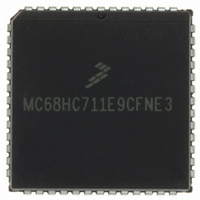MC68HC711E9CFNE3 Freescale Semiconductor, MC68HC711E9CFNE3 Datasheet - Page 170

MC68HC711E9CFNE3
Manufacturer Part Number
MC68HC711E9CFNE3
Description
IC MCU 3MHZ 12K OPT 52-PLCC
Manufacturer
Freescale Semiconductor
Series
HC11r
Specifications of MC68HC711E9CFNE3
Core Processor
HC11
Core Size
8-Bit
Speed
3MHz
Connectivity
SCI, SPI
Peripherals
POR, WDT
Number Of I /o
38
Program Memory Size
12KB (12K x 8)
Program Memory Type
OTP
Eeprom Size
512 x 8
Ram Size
512 x 8
Voltage - Supply (vcc/vdd)
4.5 V ~ 5.5 V
Data Converters
A/D 8x8b
Oscillator Type
Internal
Operating Temperature
-40°C ~ 85°C
Package / Case
52-PLCC
Processor Series
HC711E
Core
HC11
Data Bus Width
8 bit
Data Ram Size
512 B
Interface Type
SCI, SPI
Maximum Clock Frequency
3 MHz
Number Of Programmable I/os
38
Number Of Timers
8
Maximum Operating Temperature
+ 85 C
Mounting Style
SMD/SMT
Minimum Operating Temperature
- 40 C
On-chip Adc
8 bit
Lead Free Status / RoHS Status
Lead free / RoHS Compliant
Available stocks
Company
Part Number
Manufacturer
Quantity
Price
Company:
Part Number:
MC68HC711E9CFNE3
Manufacturer:
FREESCAL
Quantity:
5 530
Company:
Part Number:
MC68HC711E9CFNE3
Manufacturer:
Freescale Semiconductor
Quantity:
10 000
- Current page: 170 of 336
- Download datasheet (4Mb)
Serial Peripheral Interface (SPI)
8.6.1 Master In/Slave Out
8.6.2 Master Out/Slave In
8.6.3 Serial Clock
8.6.4 Slave Select
Technical Data
170
MISO is one of two unidirectional serial data signals. It is an input to a
master device and an output from a slave device. The MISO line of a
slave device is placed in the high-impedance state if the slave device is
not selected.
The MOSI line is the second of the two unidirectional serial data signals.
It is an output from a master device and an input to a slave device. The
master device places data on the MOSI line a half-cycle before the clock
edge that the slave device uses to latch the data.
SCK, an input to a slave device, is generated by the master device and
synchronizes data movement in and out of the device through the MOSI
and MISO lines. Master and slave devices are capable of exchanging a
byte of information during a sequence of eight clock cycles.
Four possible timing relationships can be chosen by using control bits
CPOL and CPHA in the serial peripheral control register (SPCR). Both
master and slave devices must operate with the same timing. The SPI
clock rate select bits, SPR[1:0], in the SPCR of the master device, select
the clock rate. In a slave device, SPR[1:0] have no effect on the
operation of the SPI.
The slave select (SS) input of a slave device must be externally asserted
before a master device can exchange data with the slave device. SS
must be low before data transactions and must stay low for the duration
of the transaction.
The SS line of the master must be held high. If it goes low, a mode fault
error flag (MODF) is set in the serial peripheral status register (SPSR).
To disable the mode fault circuit, write a 1 in bit 5 of the port D data
Serial Peripheral Interface (SPI)
M68HC11E Family — Rev. 3.2
MOTOROLA
Related parts for MC68HC711E9CFNE3
Image
Part Number
Description
Manufacturer
Datasheet
Request
R

Part Number:
Description:
APPENDIX A ELECTRICAL CHARACTERISTICS
Manufacturer:
FREESCALE [Freescale Semiconductor, Inc]
Datasheet:
Part Number:
Description:
Manufacturer:
Freescale Semiconductor, Inc
Datasheet:
Part Number:
Description:
Manufacturer:
Freescale Semiconductor, Inc
Datasheet:
Part Number:
Description:
Manufacturer:
Freescale Semiconductor, Inc
Datasheet:
Part Number:
Description:
Manufacturer:
Freescale Semiconductor, Inc
Datasheet:
Part Number:
Description:
Manufacturer:
Freescale Semiconductor, Inc
Datasheet:
Part Number:
Description:
Manufacturer:
Freescale Semiconductor, Inc
Datasheet:
Part Number:
Description:
Manufacturer:
Freescale Semiconductor, Inc
Datasheet:
Part Number:
Description:
Manufacturer:
Freescale Semiconductor, Inc
Datasheet:
Part Number:
Description:
Manufacturer:
Freescale Semiconductor, Inc
Datasheet:
Part Number:
Description:
Manufacturer:
Freescale Semiconductor, Inc
Datasheet:
Part Number:
Description:
Manufacturer:
Freescale Semiconductor, Inc
Datasheet:
Part Number:
Description:
Manufacturer:
Freescale Semiconductor, Inc
Datasheet:
Part Number:
Description:
Manufacturer:
Freescale Semiconductor, Inc
Datasheet:
Part Number:
Description:
Manufacturer:
Freescale Semiconductor, Inc
Datasheet:











